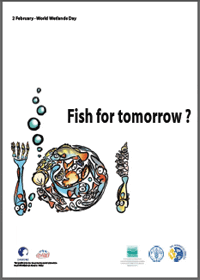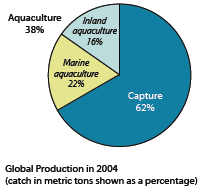Abstract
Ramsar Convention on Wetlands, an intergovernmental treaty with more than 150 member countries,
 Fish for Tomorrow? Fish for Tomorrow? |
To Catch or to Culture?
 |
Aquaculture in freshwater and coastal ecosystems has increased dramatically in recent decades and capture fisheries are being fished to their limits and beyond – so while capture fisheries still outweigh aquaculture production, the gap has narrowed.
Aquaculture now supplies more than 30% of total production but almost 40% of the fish that we eat (because some of the fish we capture is used to feed cultured fish, livestock, and poultry). It’s the fastest growing food sector in the world, and it often involves high value products: in 2004 aquaculture (including the culture of aquatic plants) was worth US$70 billion, while capture fisheries were worth US$85 billion.
Challenge for sustainable aquaculture
Aquaculture is an ancient practice with its beginnings in China, Mesopotamia and Egypt several thousand years ago, and some sites, such as the Czech Republic’s 15th century Trebon Fishponds, have been designated for the Ramsar List of Wetlands of International Importance. While early practices focused mainly on carp species, modern aquaculture involves a much greater diversity of freshwater and marine species. It takes place in both inland wetlands, such as lakes and ponds, and in coastal wetlands. It’s a diverse activity, carried out in pens, cages, rafts, and in inland ponds and rice fields, and it produces finfish, molluscs, echinoderms, crustaceans and aquatic plants. It may be carried out on a commercial scale for sale to lucrative international food markets, or it may be an activity to supplement the diet of a family or produce extra income from sales to local markets; it may even be a production system to stock lakes, rivers and coastal areas for capture fisheries (aquaculture-based fisheries), including recreational fisheries, a valuable market in some parts of the world.
The growth in aquaculture production in recent decades is making more fish available at a time when some capture fisheries are failing through over-exploitation and habitat degradation. Aquaculture can provide economic opportunities to areas that have few alternative options for development. For example, salmon farming in Chile provides over 30,000 jobs to rural people, and more than half a million people are employed in aquaculture in Vietnam, where it absorbs more labour than the capture fisheries. Aquaculture can contribute to decreasing rural emigration through providing new jobs and can contribute significantly to national economies: Vietnam forecasts that by 2010 the value of its aquaculture output could exceed US$4 billion, including aquaculture exports worth US$3 billion. Already, the contribution of aquaculture to economic activity in Vietnam is probably the highest in the world at more than 6% of GDP.
While aquaculture provides employment and a significant food source, some aquaculture practices bring environmental and social problems:
- destruction of mangroves to make way for marine aquaculture ponds;
- a heavy dependency on inputs such as energy and chemicals (antibiotics, pesticides, hormones, etc.);
- the use of wild fish as a food source, especially for farmed carnivores such as salmon and shrimps (where fishers are fishing for food to feed fish and livestock);
- pollution of local habitats through food-related wastes and chemicals;
- introduction of non-native species to the wetlands through escapes of cultured species;
- local communities deprived of the wild species they once depended upon for food security yet unable to afford the high cost of many aquaculture products; and
- displacement of local people to make way for aquaculture operations.
These problems have been recognized by many governments and development agencies, and by some members of the aquaculture industry, and progress is being made in reducing the negative impacts. Although aquaculture (and agriculture) use fish meal and fish oil, these uses provide motivation for maintaining productive fisheries of small pelagic fishes that are not strongly desired by people. Great progress has been made in reducing feed conversion factors for most aquaculture species, and fish meal is being replaced by vegetable protein, which creates positive integration between agriculture and aquaculture. The severity of environmental impacts depends to some extent on what is being farmed – in general, oyster and clam farms have fewer negative impacts than shrimp and salmon farms.
Aquaculture is the main reason for the deliberate introduction of alien species. Alien species have increased production and value from many areas. Chile is now the world’s largest producer of several species of farmed salmon, all of them alien species. Tilapia (an African freshwater fish) is more widely farmed in Asia than in its home range in Africa and provides income and needed animal protein to rural households. Yet alien species are also a significant threat to native biodiversity – European crayfish were nearly destroyed by a pathogen introduced from North America; escaped tilapia have reduced native biodiversity in Latin America. The effects of alien fish species on wetland ecosystems remains an on-going area of concern for the Ramsar Convention.
To help maximize the benefits from alien species and minimize the risks, the international community is working to create guidelines and information on the responsible use and control of alien species in fisheries and aquaculture. The International Council for the Exploration of the Sea and FAO, among others, have developed codes of practice and databases on species introductions. The records in FAO’s Database on Introductions of Aquatic Species indicate that socioeconomic benefits of alien species outweigh the ecological damage they have caused. However, guidelines and codes of practice along with good farming practices are still needed to manage alien species.
Achieving sustainability in aquaculture is possible – the technology is available and better farming practices are becoming required in national and international legislation. Much more remains to be done, of course, but progress is being made.
The Ramsar Convention recognises that aquaculture in wetlands, both coastal and inland, has the capacity to improve human wellbeing locally and nationally when managed sustainably – but its potential environmental, economic and social impacts have to be assessed and included in the decision-making and management processes so that wetlands continue to provide a broad range of services.
To continue reading this article, please click here
February 2007

